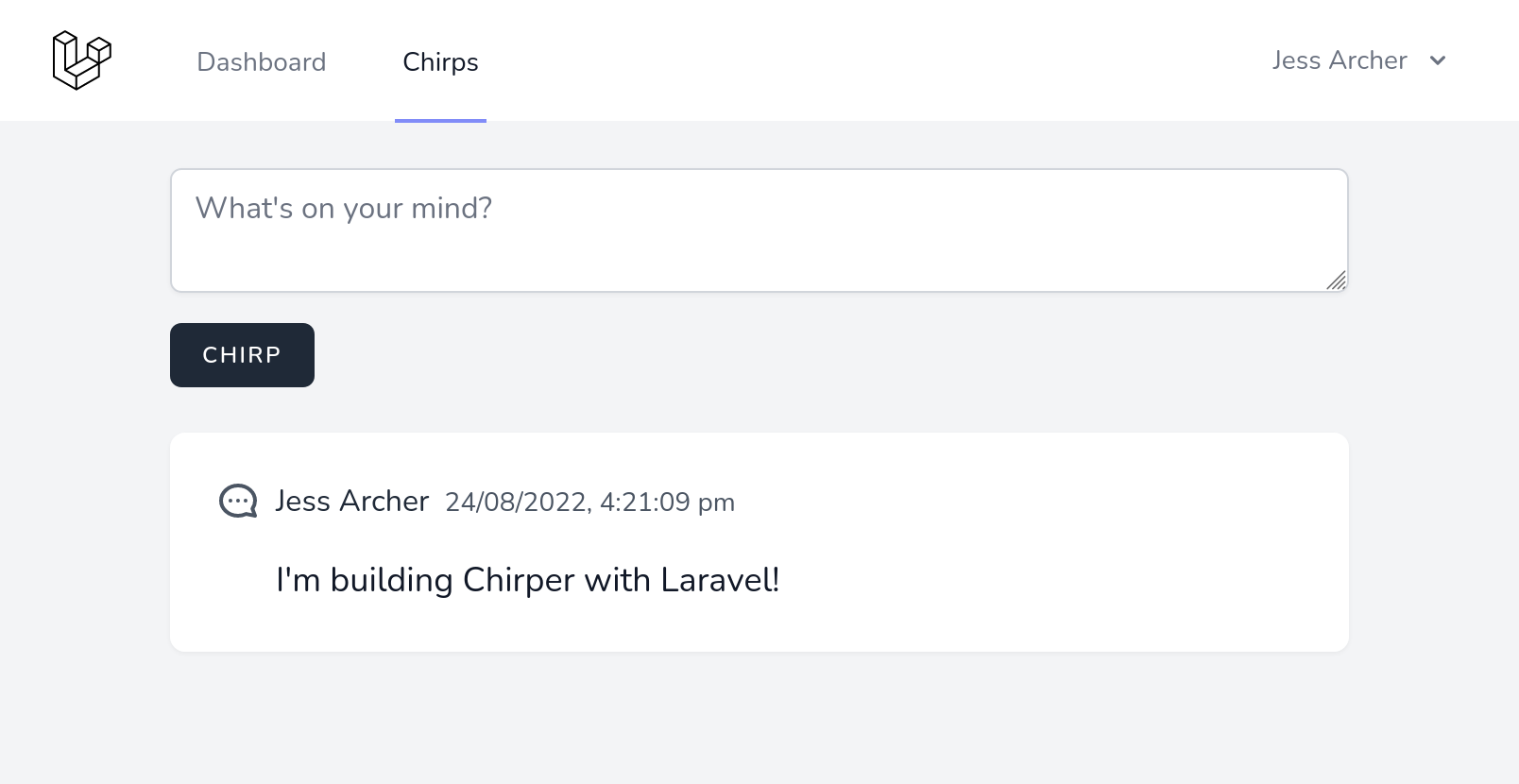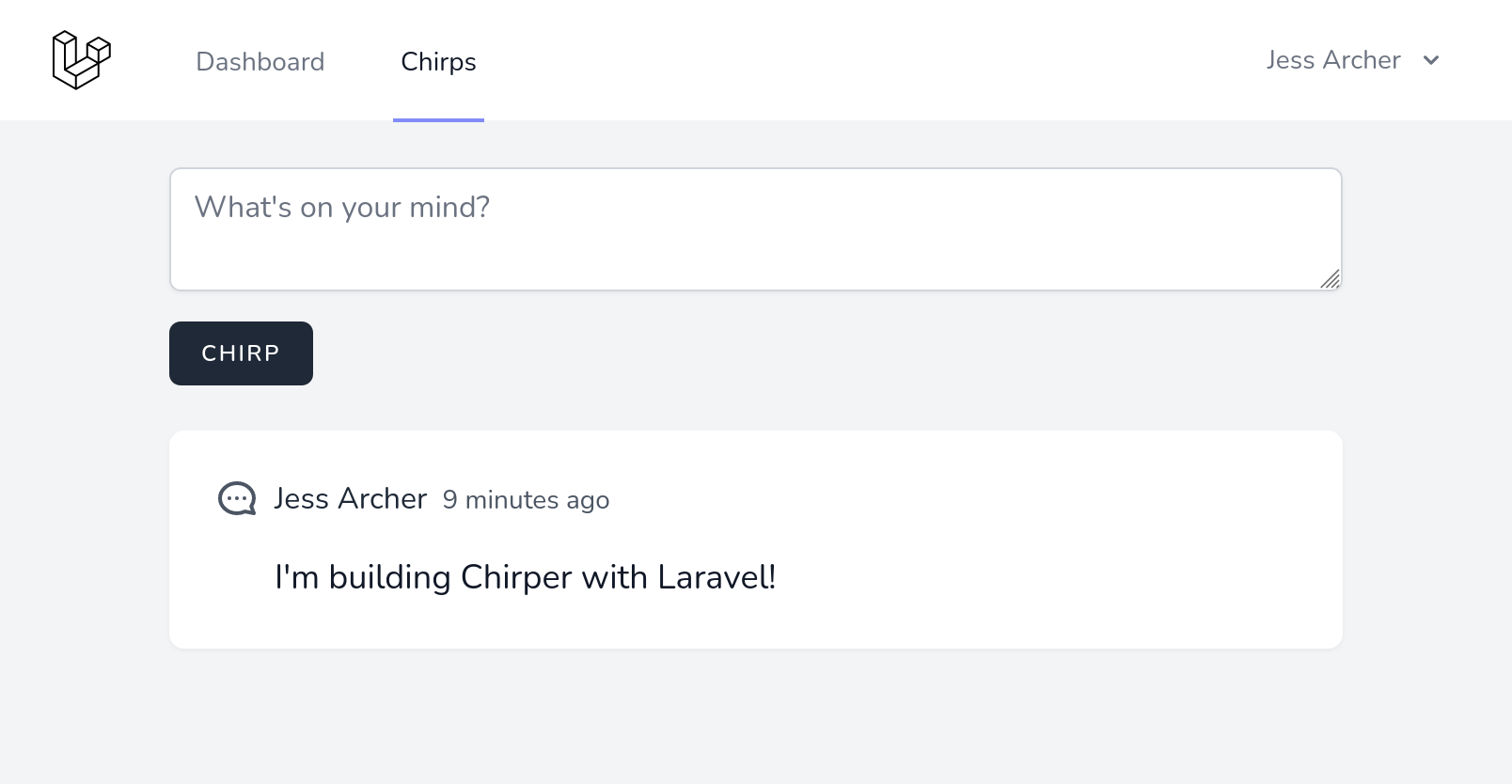04. Showing Chirps
In the previous step we added the ability to create Chirps, now we're ready to display them!
Retrieving the Chirps
Let's update the index method of our ChirpController class to pass Chirps from every user to our Index page:
<?php
namespace App\Http\Controllers; use App\Models\Chirp; use Illuminate\Http\RedirectResponse; use Illuminate\Http\Request; use Inertia\Inertia; use Inertia\Response; class ChirpController extends Controller { /** * Display a listing of the resource. */ public function index(): Response { return Inertia::render('Chirps/Index', [- //+ 'chirps' => Chirp::with('user:id,name')->latest()->get(), ]); }
/** * Show the form for creating a new resource. */ public function create() { // } /** * Store a newly created resource in storage. */ public function store(Request $request): RedirectResponse { $validated = $request->validate([ 'message' => 'required|string|max:255', ]); $request->user()->chirps()->create($validated); return redirect(route('chirps.index')); } /** * Display the specified resource. */ public function show(Chirp $chirp) { // } /** * Show the form for editing the specified resource. */ public function edit(Chirp $chirp) { // } /** * Update the specified resource in storage. */ public function update(Request $request, Chirp $chirp) { // } /** * Remove the specified resource from storage. */ public function destroy(Chirp $chirp) { // } }Here we've used Eloquent's with method to eager-load every Chirp's associated user's ID and name. We've also used the latest scope to return the records in reverse-chronological order.

Returning all Chirps at once won't scale in production. Take a look at Laravel's powerful pagination to improve performance.
Connecting users to Chirps
We've instructed Laravel to return the id and name property from the user relationship so that we can display the name of the Chirp's author without returning other potentially sensitive information such as the author's email address. But, the Chirp's user relationship hasn't been defined yet. To fix this, let's add a new "belongs to" relationship to our Chirp model:
<?php
namespace App\Models; use Illuminate\Database\Eloquent\Factories\HasFactory; use Illuminate\Database\Eloquent\Model;+use Illuminate\Database\Eloquent\Relations\BelongsTo; class Chirp extends Model {
use HasFactory; protected $fillable = [ 'message', ]; + public function user(): BelongsTo+ {+ return $this->belongsTo(User::class);+ } }This relationship is the inverse of the "has many" relationship we created earlier on the User model.
Updating our component
Next, let's create a Chirp component for our front-end. This component will be responsible for displaying an individual Chirp:
<script setup>defineProps(['chirp']);</script> <template> <div class="p-6 flex space-x-2"> <svg xmlns="http://www.w3.org/2000/svg" class="h-6 w-6 text-gray-600 -scale-x-100" fill="none" viewBox="0 0 24 24" stroke="currentColor" stroke-width="2"> <path stroke-linecap="round" stroke-linejoin="round" d="M8 12h.01M12 12h.01M16 12h.01M21 12c0 4.418-4.03 8-9 8a9.863 9.863 0 01-4.255-.949L3 20l1.395-3.72C3.512 15.042 3 13.574 3 12c0-4.418 4.03-8 9-8s9 3.582 9 8z" /> </svg> <div class="flex-1"> <div class="flex justify-between items-center"> <div> <span class="text-gray-800">{{ chirp.user.name }}</span> <small class="ml-2 text-sm text-gray-600">{{ new Date(chirp.created_at).toLocaleString() }}</small> </div> </div> <p class="mt-4 text-lg text-gray-900">{{ chirp.message }}</p> </div> </div></template>import React from 'react'; export default function Chirp({ chirp }) { return ( <div className="p-6 flex space-x-2"> <svg xmlns="http://www.w3.org/2000/svg" className="h-6 w-6 text-gray-600 -scale-x-100" fill="none" viewBox="0 0 24 24" stroke="currentColor" strokeWidth="2"> <path strokeLinecap="round" strokeLinejoin="round" d="M8 12h.01M12 12h.01M16 12h.01M21 12c0 4.418-4.03 8-9 8a9.863 9.863 0 01-4.255-.949L3 20l1.395-3.72C3.512 15.042 3 13.574 3 12c0-4.418 4.03-8 9-8s9 3.582 9 8z" /> </svg> <div className="flex-1"> <div className="flex justify-between items-center"> <div> <span className="text-gray-800">{chirp.user.name}</span> <small className="ml-2 text-sm text-gray-600">{new Date(chirp.created_at).toLocaleString()}</small> </div> </div> <p className="mt-4 text-lg text-gray-900">{chirp.message}</p> </div> </div> );}Finally, we will update our Chirps/Index page component to accept the chirps prop and render the Chirps below our form using our new component:
<script setup> import AuthenticatedLayout from '@/Layouts/AuthenticatedLayout.vue';+import Chirp from '@/Components/Chirp.vue'; import InputError from '@/Components/InputError.vue'; import PrimaryButton from '@/Components/PrimaryButton.vue'; import { useForm, Head } from '@inertiajs/vue3'; +defineProps(['chirps']); const form = useForm({ message: '', }); </script> <template> <Head title="Dashboard" /> <AuthenticatedLayout> <div class="max-w-2xl mx-auto p-4 sm:p-6 lg:p-8"> <form @submit.prevent="form.post(route('chirps.store'), { onSuccess: () => form.reset() })"> <textarea v-model="form.message" placeholder="What's on your mind?" class="block w-full border-gray-300 focus:border-indigo-300 focus:ring focus:ring-indigo-200 focus:ring-opacity-50 rounded-md shadow-sm" ></textarea> <InputError :message="form.errors.message" class="mt-2" /> <PrimaryButton class="mt-4">Chirp</PrimaryButton> </form> + <div class="mt-6 bg-white shadow-sm rounded-lg divide-y">+ <Chirp+ v-for="chirp in chirps"+ :key="chirp.id"+ :chirp="chirp"+ />+ </div> </div> </AuthenticatedLayout> </template> import React from 'react'; import AuthenticatedLayout from '@/Layouts/AuthenticatedLayout';+import Chirp from '@/Components/Chirp'; import InputError from '@/Components/InputError'; import PrimaryButton from '@/Components/PrimaryButton'; import { useForm, Head } from '@inertiajs/react'; -export default function Index({ auth }) {+export default function Index({ auth, chirps }) { const { data, setData, post, processing, reset, errors } = useForm({ message: '', }); const submit = (e) => { e.preventDefault(); post(route('chirps.store'), { onSuccess: () => reset() }) }; return ( <AuthenticatedLayout> <Head title="Chirps" /> <div className="max-w-2xl mx-auto p-4 sm:p-6 lg:p-8"> <form onSubmit={submit}> <textarea value={data.message} placeholder="What's on your mind?" className="block w-full border-gray-300 focus:border-indigo-300 focus:ring focus:ring-indigo-200 focus:ring-opacity-50 rounded-md shadow-sm" onChange={e => setData('message', e.target.value)} ></textarea> <InputError message={errors.message} className="mt-2" /> <PrimaryButton className="mt-4" disabled={processing}>Chirp</PrimaryButton> </form> + <div className="mt-6 bg-white shadow-sm rounded-lg divide-y">+ {chirps.map(chirp =>+ <Chirp key={chirp.id} chirp={chirp} />+ )}+ </div> </div> </AuthenticatedLayout> ); }Now take a look in your browser to see the message you Chirped earlier!

Extra Credit: Relative dates
In our Chirp component we formatted the dates to be human-readable, but we can take that one step further by displaying relative dates using the popular Day.js library.
First, install the dayjs NPM package:
npm install dayjsThen we can use this library in our Chirp component to display relative dates:
<script setup>+import dayjs from 'dayjs';+import relativeTime from 'dayjs/plugin/relativeTime'; +dayjs.extend(relativeTime); defineProps(['chirp']); </script> <template> <div class="p-6 flex space-x-2"> <svg xmlns="http://www.w3.org/2000/svg" class="h-6 w-6 text-gray-600 -scale-x-100" fill="none" viewBox="0 0 24 24" stroke="currentColor" stroke-width="2"> <path stroke-linecap="round" stroke-linejoin="round" d="M8 12h.01M12 12h.01M16 12h.01M21 12c0 4.418-4.03 8-9 8a9.863 9.863 0 01-4.255-.949L3 20l1.395-3.72C3.512 15.042 3 13.574 3 12c0-4.418 4.03-8 9-8s9 3.582 9 8z" /> </svg> <div class="flex-1"> <div class="flex justify-between items-center"> <div> <span class="text-gray-800">{{ chirp.user.name }}</span>- <small class="ml-2 text-sm text-gray-600">{{ new Date(chirp.created_at).toLocaleString() }}</small>+ <small class="ml-2 text-sm text-gray-600">{{ dayjs(chirp.created_at).fromNow() }}</small> </div> </div> <p class="mt-4 text-lg text-gray-900">{{ chirp.message }}</p> </div> </div> </template> import React from 'react';+import dayjs from 'dayjs';+import relativeTime from 'dayjs/plugin/relativeTime'; +dayjs.extend(relativeTime); export default function Chirp({ chirp }) { return ( <div className="p-6 flex space-x-2"> <svg xmlns="http://www.w3.org/2000/svg" className="h-6 w-6 text-gray-600 -scale-x-100" fill="none" viewBox="0 0 24 24" stroke="currentColor" strokeWidth="2"> <path strokeLinecap="round" strokeLinejoin="round" d="M8 12h.01M12 12h.01M16 12h.01M21 12c0 4.418-4.03 8-9 8a9.863 9.863 0 01-4.255-.949L3 20l1.395-3.72C3.512 15.042 3 13.574 3 12c0-4.418 4.03-8 9-8s9 3.582 9 8z" /> </svg> <div className="flex-1"> <div className="flex justify-between items-center"> <div> <span className="text-gray-800">{chirp.user.name}</span>- <small className="ml-2 text-sm text-gray-600">{new Date(chirp.created_at).toLocaleString()}</small>+ <small className="ml-2 text-sm text-gray-600">{dayjs(chirp.created_at).fromNow()}</small> </div> </div> <p className="mt-4 text-lg text-gray-900">{chirp.message}</p> </div> </div> ); }Take a look in the browser to see your relative dates.

Feel free to Chirp some more, or even register another account and start a conversation!
